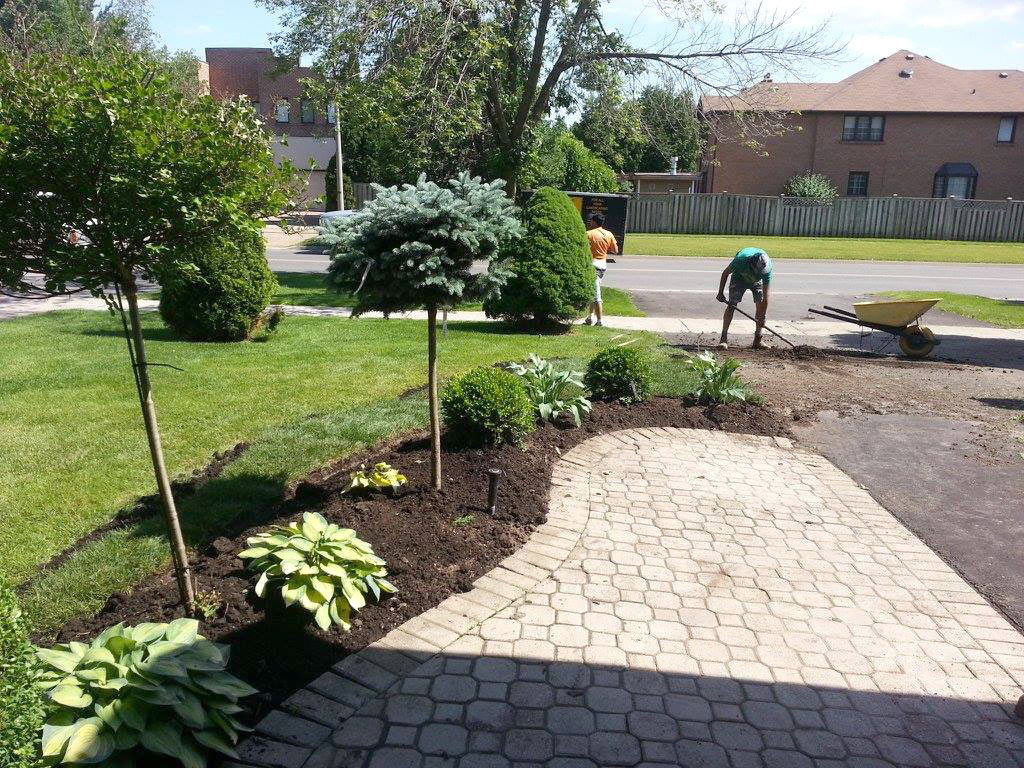Your lawn is supposed to be lush and green.
Now it’s patchy, faded, or covered in large brown spots. Not exactly the barefoot-friendly oasis you imagined.
“Why is my grass turning brown?”
In Toronto, lawns often turn brown from heat stress, drought, pests (like grubs or chinch bugs), fungal diseases, compacted soil, nutrient deficiencies, or pet urine damage. Cool-season grasses may also go dormant in summer heat. The fix is to water deeply 2–3 times a week, mow high, aerate compacted soil, fertilize in spring and fall, and treat pests or diseases promptly.
Let’s walk through the most common causes and what you can do to fix them — and prevent brown patches from returning.

1. Lack of Water
It might seem obvious, but your lawn needs consistent moisture to stay green.
In midsummer, most Toronto lawns need about 2.5–4 cm (1–1.5 inches) of water per week.
- Best practice: Deep, infrequent watering — twice a week — is better than light daily watering.
- Check depth: Use a screwdriver to test penetration; it should easily push 15 cm (6 inches) into moist soil.
- Avoid overwatering: Too much water encourages fungus and weakens roots.
Make sure sprinkler coverage is even — many brown patches come from uneven irrigation rather than drought.
2. Lawn Diseases
Warm, humid conditions create a breeding ground for fungal diseases like brown patch, dollar spot, and rust.
- Signs: Circular brown spots, patches expanding in rings, visible mold or powdery growth.
- Treatment: Apply a fungicide suited for the diagnosed disease; mow only when grass is dry; bag clippings to avoid spreading spores.
- Prevention:
- Aerate compacted soil in fall.
- Water early in the morning.
- Keep mower blades sharp and mow at the right height.


3. Prevent Fungus With Aeration
Toronto’s clay-heavy soils compact easily, suffocating roots and trapping moisture.
- Why it matters: Compacted soil prevents water and nutrients from penetrating, stressing grass and encouraging disease.
- Solution: Core aeration in spring or fall, followed by overseeding, improves root depth, drought tolerance, and resistance to pests and fungus.
4. Lawn Pests
Tiny insects can do big damage. The most common brown-lawn culprits in southern Ontario are white grubs and chinch bugs.
White Grubs
Feed on the grassroots, preventing water and nutrient uptake.
- Signs: Grass lifts up easily like a carpet; irregular brown patches appear in late summer.
- Fix: Apply grub control in late summer; reseed damaged areas.
Chinch Bugs
Suck plant juices and inject toxins that block water movement.
- Signs: Wilted grass turning yellow, then brown, especially in hot, sunny spots.
- Fix: Early insecticide treatment in spring or early summer; keep lawn well-watered during droughts.


5. Nutrient Deficiency & Soil pH
Lawns need a balanced diet. A nitrogen deficiency or acidic soil can trigger browning.
Solution:
- Test soil every 2–3 years.
- Keep pH between 6.0–7.0; apply lime if soil is too acidic.
- Use a balanced slow-release fertilizer in spring and fall.
6. Pet Waste
Dog urine contains nitrogen and salts that burn grass.
- Signs: Small round brown spots with dark green edges.
- Fix:
- Train pets to use a designated area.
- Water spots immediately after urination.
- Walk your dog before allowing them on the lawn in the morning, when urine is most concentrated.


7. Weather & Mowing Stress
Hot, dry weather can push cool-season grasses into temporary dormancy — a natural defense mechanism.
- Tip: Keep grass at least 6–8 cm high to shade roots.
- Avoid: Cutting more than one-third of blade height in a single mow, or mowing with dull blades.
How JHC Landscaping Can Help
The only way to know for sure why your grass is brown is with a close, professional inspection.
Our comprehensive lawn analysis includes:
- Root and soil health check
- Pest and disease identification
- Irrigation system review
- Tailored treatment plan for your property
Whether it’s aeration, overseeding, targeted pest control, or a custom fertilization program, we’ll get your lawn green again — and keep it that way.
Call JHC Landscaping today for your lawn assessment and reclaim your green space.
FAQ
Yes — if the roots are still alive. Dormant or stressed grass will green up within 2–4 weeks with deep watering, balanced fertilization, and improved soil conditions. If grass is completely dead from pests or severe damage, reseeding or resodding is necessary.
In summer, water deeply 2–3 times per week to deliver 2.5–4 cm (1–1.5 inches) of water. Early morning watering reduces evaporation and fungal risk. Avoid daily shallow watering — it encourages weak, shallow roots.
Patchy browning is often due to uneven sprinkler coverage, pet urine, fungal disease, or localized pest damage. Inspect affected areas closely and address the specific cause before it spreads.
The best times are spring or fall, when grass is actively growing. Aeration relieves soil compaction, improves nutrient absorption, and helps prevent disease — especially important in Toronto’s clay soils.
